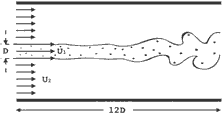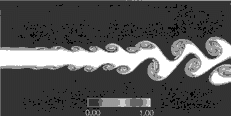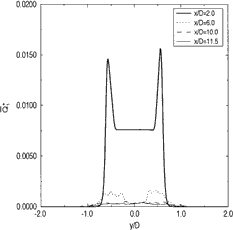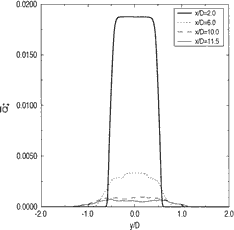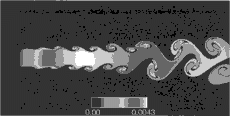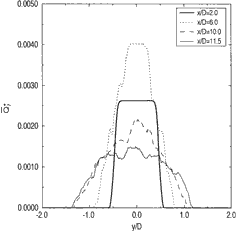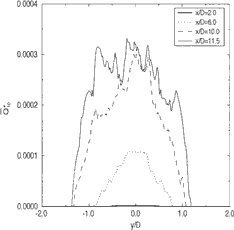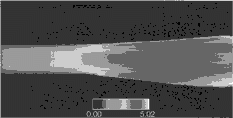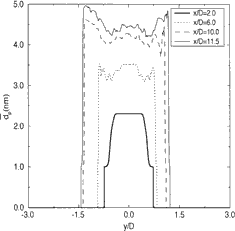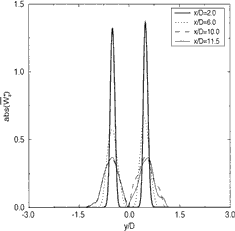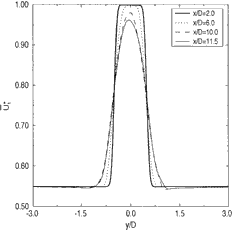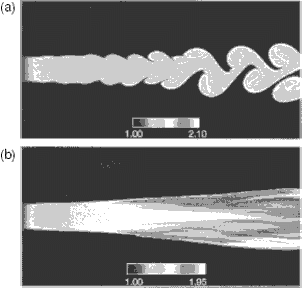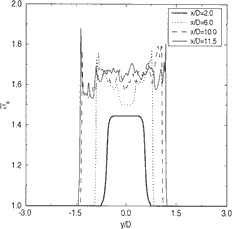Abstract
Direct numerical simulation of nanoparticle coagulation in a planar jet is performed. The particle field is represented using a sectional method to approximate the aerosol general dynamic equation. The methodology is advantageous in that there are no a priori assumptions regarding the particle size distribution and coupled with an unsteady Navier-Stokes solver, it provides the spatio-temporal evolution of the particle field in an accurate manner. The jet consists of an incompressible fluid containing particles 1 nm in diameter issuing into a particle-free coflowing stream. Ten sections are solved allowing the particle field to develop to 8 nm in diameter. Results show that the geometric standard deviation reaches the self-preserving value within one jet diameter downstream of the nozzle and remains at that value up to 7.5 jet diameters. In this proximal region, the particle size is relatively uniform throughout the jet. Further downstream, the effects of large-scale vortical structures is to increase the residence time of particles within the domain and perturb the geometric standard deviation beyond the self-preserving value.
INTRODUCTION
Turbulent flows containing nanoscale particles are finding a number of applications in engineering and technology (CitationPratsinis 1998; CitationWooldridge 1998; CitationXiong and Pratsinis 1991; CitationDagani 2000). The interaction between the particles and the fluid field plays an important role in designing, developing, and determining the performance of engineering devices. These include, but are not limited to, flue gas cleaning (CitationLinak and Wendt 1999; CitationLind et al. 1993), nuclear reactor safety analysis (CitationMäkynen et al. 1997), fouling of heat exchangers (CitationBryers 1996; CitationJokiniemi et al. 1996), and flame aerosol synthesis of ultrapure materials (CitationPratsinis 1998; CitationMatsoukas and Friedlander 1991; CitationFotou et al. 1994). Currently, experimental methods are limited by the spatial and temporal resolution rendering direct measurement of the collision rates between particles unfeasible. The broad range of applications of turbulent coagulation and its effect on the evolution of the particle size distribution of an aerosol are not well understood. Much effort has been put fourth to simulate particles within turbulent flows, including studies of preferential concentration, particle dispersion, and the turbulence-particle interactions (CitationYuu et al. 1996; CitationFrishman et al. 1997; CitationSarkar and Lakshmanan 1991; CitationElghobashi and Truesdell 1993; CitationEaton and Fessler 1994; CitationSquires and Eaton 1991; CitationAhmed and Elghobashi 2000; CitationUthuppan et al. 1994; CitationHansell et al. 1992; CitationChein and Chung 1987; CitationWen et al. 1992; CitationWang 1992). However, to date little work has focused on the dynamics and growth of nanoparticles in turbulent flows.
Methods which can be used in representing nanoparticle fields in fluid-particle systems include Lagrangian methods, moment methods, and sectional methods (CitationFrenklach and Harris 1987; CitationBarrett and Jheeta 1996; CitationGelbard and Seinfeld 1980; CitationGelbard et al. 1980). Lagrangian or particle-tracking methods compute the trajectories of individual particles as they evolve throughout the flow domain (CitationReade and Collins 2000a, Citationb; CitationSundaram and Collins 1997). The Lagrangian or particle-tracking approach performs well in isotropic homogenous flows but suffer from large computational requirements in inhomogeneous flows. This is due to the large number of particles needed at each location in space to provide statistical accuracy. Eulerian methods such as moment or sectional methods avoid the need to represent each particle by casting the problem in terms of “average” quantities at a fixed location in time and space. The method of moments is advantageous because it solves for the particle size distribution (PSD) by introducing only a few additional transport equations (CitationBrock and Oates 1987; CitationWright et al. 2001; CitationSettumba and Garrick 2003). One potential shortcoming of the method of moments is the a priori prescription of PSD which may need to be provided (CitationKielkiewcz 1994). In its most computationally affordable implementation, in which only three moments are obtained, the approach requires the assumption of the particle size distribution (CitationSettumba and Garrick 2003). The sectional method is advantageous over the moment method in that knowledge of the PSD is not required (CitationGelbard and Seinfeld 1980; CitationGelbard et al. 1980). Sectional or nodal methods effectively discretizes the particle size domain into a finite number of “bins,” or sections, corresponding to particle volume (CitationGelbard and Seinfeld 1980; CitationGelbard et al. 1980; CitationModem and Garrick 2003; CitationModem, 2002; CitationModem et al. 2002). A disadvantage of the sectional approach is that each section or bin corresponds to a transport equation which must be solved, which can be prohibitively expensive computationally.
Recent advances in computational power have rendered sectional representations feasible (CitationHounslow et al. 1988; CitationTsantilis and Pratsinis 2000). CitationPyykönen and Jokiniemi (2000) employed a sectional method in conjunction with a Reynolds-averaged Navier-Stokes solver to simulate aerosol formation via nucleation, condensation, and coagulation. CitationXiong and Pratsinis (1993) extended a one-dimensional sectional technique to two dimensions to obtain the evolution of both particle size and shape during gas phase production of titania and silica powders. CitationLu et al. (1998) simulated particle growth of TiO2 nanoparticles in a tubular chemical vapor deposition reactor for laminar steady-state jets via a discrete-sectional model. The dominant growth mechanism in many aerosol processes is coagulation (CitationAblitzer et al. 2001). CitationDagani (2000) studied the synthesis of palladium nanoparticles inside a aerosol flow condenser and found that coagulation was the dominant mechanism for particle growth. A similar study by CitationNakaso et al. (1997) found that at high temperatures coalescence is primarily responsible for particle growth. CitationXiong and Pratsinis (1991) used both sectional and moment methods to analyze Brownian and turbulent shear-induced coagulation and concluded that initially particle formation is controlled by Brownian coagulation. Direct numerical simulation (DNS) may be able to provide insights into the relationship between fluid field, particle properties, and collision kernels. CitationYu et al. (1998) developed a DNS technique to simulate particle formation and growth in laminar flames which correlated well with experiment. Large-scale industrial flow reactors typically operate under turbulent flow conditions. However, the application of numerical simulations in general, and DNS in specific, to turbulent flows has been rather limited to homogeneous flows (CitationReade and Collins 2000a, Citationb; CitationMoody and Collins 2003).
In this work we perform DNS of a coagulating aerosol in a two-dimensional, incompressible, isothermal planar jet. The evolution of the particle field is obtained by utilizing a sectional model to approximate the aerosol general dynamic equation (GDE). The GDE is written in discrete form as a population balance on each cluster or particle size and describes particle dynamics under the influence of various physical phenomena: convection, diffusion, and coagulation. This representation facilitates the capture of the underlying physics in a time-accurate manner. Though the flows are two-dimensional and therefore not turbulent, many of the physics contained within turbulent flows are present in two-dimensional flows (CitationDesJardin and Frankel 1998; CitationNarayanan et al. 2003; CitationKurzweil et al. 2003; CitationUchiyama and Naruse 2003). The goal of this work is thus to obtain a better prediction of fluid-particle systems and to elucidate the underlying structure of vapor-phase particle growth processes. Such model free simulations can provide data which can then be used to test or assess the validity of turbulence models for use in nanoparticle flows (CitationGivi 1989; CitationWu and Menon 2001).
FORMULATION
Fluid Transport
The flows under consideration are isothermal and incompressible. They are governed by the conservation of mass and momentum equations:
Particle Transport
The transport of the nanoscale particles dispersed throughout the fluid is governed by the aerosol GDE. The GDE describes particle dynamics under the influence of various physical and chemical phenomena: convection, diffusion, coagulation, surface growth, nucleation, and the other internal/external forces. The GDE is written in discrete form as a population balance on each cluster or particle size. From a practical point, however, such a system of equations cannot be solved explicitly except for very small particle sizes—typically <1000 molecular or “monomer” units. To mitigate this and other issues, a nodal approach is used to describe the particle size distribution in time and space. The methodology is essentially a sectional approach in which the particle properties are averaged over each section and is the methodology used by CitationLehtinen and Zachariah (2001). The approach is advantageous in that there are no a priori assumptions regarding the particle size distribution and it does not suffer from the severe constraints of other methodologies (CitationGelbard and Seinfeld 1980; CitationGelbard et al. 1980; CitationZachariah and Semerjian 1989). The nodal effectively divides the particle size distribution into “bins.” Instead of solving the GDE, we solve N s equations—one for concentration of particles in each bin—where N s is the number of bins. This representation facilitates the capture of the physics underlying fluid-particle interactions. In adopting this framework we can write a general transport equation for the concentration of particles in the kth node, Q k (CitationXiong and Pratsinis 1993) as
RESULTS
Flow Configuration
The flow consists of a fluid issuing from a planar jet of diameter D=1 mm into a coflowing stream. The spatial coordinates are x = [x, y], where x is the streamwise direction and y is the cross-stream direction, as shown in . The initial velocities are U
1=95 m/s for the jet and U
2 for the coflowing stream. The velocity ratio is chosen to be U
1/U
2=0.55. The flow is incompressible and isothermal, at a temperature of T=300 K, and the Reynolds number based on velocity of the high-speed stream and the jet diameter roughly Re = U
1
D/ν=4000. While this flow is naturally unstable, random perturbations, 3% of U
1 in magnitude, are added to the cross-stream velocity in order to accelerate the development of the large-scale structures. At the jet exit, x/D=0, particles 1 nm in diameter are injected. As the jet travels downstream, particle collisions give rise to new class sizes. A total of ten bins are solved for, i.e., N
s
=10. This facilitates the solution for particles covering a range of three orders of magnitude in volume and the particle diameter ranges from d
p
=1 nm to d
p
=8 nm. The particle Schmidt number, Sc, defined as the ratio of the fluid momentum diffusivity to the particle mass diffusivity, ranges from Sc
p
=5.47 to Sc
p
=343.0. The relationship between the bin number, particle diameter, and particle Schmidt number is shown in . The volume fraction, or the ratio of the volume occupied by the particles to that occupied by the gas, is Φ=1.0 × 10−7, resulting in 1.78 × 1020 particles per m3 of air entering the flow domain each second. Due to the computational expense of the simulation, the number of bins or nodes is relatively low. However, results from simulations using 10 and 15 sections in simulation nanoparticle coagulation in temporal mixing layers have indicated that the difference in growth rate is relatively small for the volume fraction considered (CitationKhakpour and Garrick 2003; CitationModem et al. 2002). The conserved scalar φ issuing with the jet has a Schmidt number of Scφ=5.47, equal to that of the 1 nm diameter particles. This provides what may be thought of as a view of the particle field without the effects of Brownian coagulation.
TABLE 1 Bin number, particle diameters, and Schmidt numbers
The governing transport equations are solved using a hybrid MacCormack-based compact difference scheme (CitationMacCormack 1969; CitationCarpenter 1990). The numerical scheme used is based on the one-parameter family of dissipative two-four schemes developed by CitationCarpenter (1990)). The accuracy of the scheme is second order in time and fourth order in space. The exact details of the numerical schemes employed in this study are not given here, but a catalog of these schemes and others are readily available (CitationCarpenter 1990; CitationKennedy and Carpenter 1994). To increase the computational effciency a nonuniformly spaced grid is employed. Grid point clustering is performed in a manner which increases the number of grid points near the interface of the jet and coflowing streams. The computational code is written using the Message Passing Interface to make use of large number of processing units. The code exhibits linear speed-up when executing on as many as 400 processors. The simulation utilized 250 processors and required 115,000 CPU hours for completion. This is due to the large number of grid points required to resolve the diffusion length scales associated with nanoparticle transport as implemented in sectional/nodal methods.
Both instantaneous and time-averaged data are presented. This dual view of the fluid and particle fields allows both qualitative and quantitative assessments. Time-averaged data typically employ 155,000 samples. This is sufficient for one sweep of the low-speed stream. The sampling process begins after the coflowing stream has swept through the domain once. At a nondimensional time of t* = tU 1/D=21.8, the values of all variables at each grid point are recorded. The delay in the sampling process allows any initial transients to “wash” through the domain. Sampling continues until time t* =43.6. Time-averaged quantities thus correspond to measurements over a period of 1.7 × 10−4 are denoted with an overbar. Additionally, all particle concentrations are normalized by the number of 1 nm diameter particles at the inlet, i.e., Q* k = Q k /Q 1 o .
Fluid Field
The underlying fluid field may be illustrated by the vorticity field. The vorticity is a measure of the instantaneous rotation rate of the principal axes and is computed by taking the curl of the velocity field, Ω z =(∂v/∂x−∂u/∂y). shows an instantaneous snapshot of the vorticity at time t* =26.2. As evident in the figure, the vorticity is generated at the velocity gradient between the jet and the coflowing streams forming two shear layers. The shear layers remain relatively stable for the first 3.5 diameters downstream of the jet exit. Once the eddies form, they pair and merge near x/D=10. As the flow travels downstream, the peak vorticity magnitude decreases due to the transfer of momentum and viscous damping.
Scalar Field
The conserved scalar may be thought of as 1 nm diameter particles, undergoing coagulation-free motion. The diffusion coefficient of the scalar is that of the 1 nm particles contained in bin k=1, i.e., Scφ=5.47. Instantaneous contours of the conserved scalar φ at time t* =26.2 are shown in . This representation helps to elucidate the influence of the eddies and vortex motion on the particle distribution. The image shows that as the eddies begin to develop near x/D=3.5 the jet entrains fluid from the coflowing streams which has a concentration of φ=0. Further downstream, the eddies grow, the jet spreads, and more fluid originating from the coflowing streams is entrained, thereby diluting the jet. The effects of large-scale transport is evident as the species-free fluid crosses the jet centerline. The effects of diffusion are evident in the striations and small-scale features present within the cores of the eddies. The diffusion of momentum is more than 5.47 times greater than that of the scalar φ. As a result, scalar concentration gradients are sharper and decrease less rapidly than momentum or vorticity gradients (CitationOttino 1989).
Size-Selected Particle Field
shows cross-stream profiles of the time-averaged particle concentration at x/D=2, 6, 10, and 11.5. The figure quantitatively shows that the 1 nm particles are found in larger numbers along the shear layers. At x/D=2, the concentration along the shear layers is twice the concentration in the jet core, while at x/D=6 it is four times as large. By x/D=6, the concentration in the shear layers has dropped by 880%. Beyond x/D=6, the 1 nm particles within the jet core are no longer evolving, suggesting that the particle concentration in this region has achieved asymptotic behavior. Along the shear layers, the concentration is still evolving and becomes equivalent to the jet center by x/D=10, Q* 1=3.10 × 10−4. The figure also reveals a spreading in the particle concentration profile as the jet travels downstream. The particles diffuse across the concentration gradient, which has the effect of lowering the concentration in the jet core while increasing it in interfacial regions. The growth rate is proportional to the square of the number concentration, and therefore the particles grow more slowly in the interfacial region. This reduced growth rate is reflected in a higher number of 1 nm diameter particles located along the edge of the jet. The magnitude of the concentration changes may be observed in the time-averaged data.
Contours of the larger 2 nm diameter particle concentration are shown in . Initially zero, Q* 4 increases to a maximum near x/D=1 and then decreases for the length of the domain. The figure also reveals that particles with a diameter of 2 nm are able to exist for the entire length of the flow field, though in relatively low numbers. Structurally, indicates that the 2 nm particles have a nearly uniform concentration throughout the eddies. This means that the particles must form before the eddies. After the eddy forms, the time required to travel a fixed distance downstream is not uniform across the eddy. This nonuniform u-velocity produces different residence times which would yield nonuniform growth rates. Such differences would be visible in the form of “pockets” or regions of the eddies free of 2 nm diameter particles. Cross-stream profiles of the time-averaged concentration are shown in . At x/D=2, the maximum concentration is
, which is 20% higher than the maximum concentration of 1 nm diameter particles at the same location. The concentration of 2 nm particles at x/D=2 is highest in the jet core and decreases in the cross-stream direction. Contrary to the smaller 1 nm particles, the 2 nm particle concentration in the core of the jet continues to evolve beyond x/D=6. The effect of largescale or convective transport is observed by the increase in the width of the concentration profiles. The width—taken to be the distance from the centerline to the location where particulate mass exists—increases 40% by x/D=6 and 110% by x/D=11.5, relative to x/D=2.
Instantaneous contours of the concentration of 4 nm diameter particles, Q* 7, at time t* =26.2 are shown in . The image shows that the number of particles peak roughly four jet diameters downstream of the jet exit. The figure shows that the eddies between x/D=4 and x/D=6 contain fewer 4 nm particles than the same fluid along the jet core. A feature not present in the concentration contours of the smaller particles is the maintenance of particle-free fluid (Q* 4=0) entrained by the eddy in the first half of the domain (x/D<6). That is, throughout the flow domain, the eddies contain pockets of fluid which contain no “large” particles. This is due to the fact that larger particles are less mobile and not able to diffuse from the particle-containing fluid into the particle-free fluid. Though there is macroscale mixing of the two via convection, micromixing via diffusion is minimal. The evolution of the 4 nm diameter particle concentration is quantified in the time-averaged, cross-stream profiles shown in . The effectiveness of convection is again visible in the widening of the profiles. The increase in the width of the particle concentration profiles at all streamwise location is equivalent to the increases observed in the 2 nm particles, showing that the large-scale transport of particulate mass away from the jet center is independent of particle size.
Turning to the largest particles, the instantaneous concentration of 8 nm diameter particles at time t* =26.2 is shown in . The 8 nm diameter particles are contained in the last bin, k=8. The image shows that the largest particles exist in small numbers, if at all, before x/D=4. As the eddies pair near x/D=8, the concentration on the periphery of the eddy exceeds that along the jet centerline. This is attributed to particles within the eddy having a longer residence time (through the flow domain) than particles near y/D=0. As these are the largest particles, their number does not decrease as the particles grow. At positions where large-scale transport dominates mass dispersion, x/D=10 and x/D=11.5, a large number of scales are represented as observed in the profiles. Large concentration gradients are sustained because the particle diffusivity for 8 nm particles is very low. Their Schmidt number is Sc k=10=342.99, two orders of magnitude larger than the Schmidt number of the smallest particles.
FIG. 9 Instantaneous contours of the normalized particle concentration Q* 10 (d p =8 nm) at time t* =26.2.

The time-averaged concentration profiles are shown in . At x/D=2, few particles 8 nm in diameter have formed. The maximum concentration is × 10−6. At x/D=6, the concentration increases to
. The concentrations at locations x/D=10 and x/D=11.5 are nearly equivalent at
. However the concentration profile is more broad, with larger numbers of 8 nm diameter particles being found off the jet centerline at the further downstream location x/D=11.5.
Statistics of the PSD
The growth of the particles may be summarized by the evolution of the mean particle diameter d m , which is calculated from the mean volume d m =(6v m /π)1/3, where the mean volume v m is given by
The geometric standard deviation (GSD) σ g is a measure of the width of the PSD (CitationFuchs 1964; CitationFriedlander 1977) and is given by
Both instantaneous and time-averaged contours of the GSD are shown in . The values range from σ g =1 to σ g =2.1. At the inlet, the particle field is monodisperse and σ g =1. By x/D=4.75 the GSD is that of the self-preserving distribution, σ g =1.50. This is larger than the theoretical asymptotic limit σ g =1.46 for particles in the free molecular regime undergoing Brownian coagulation (CitationFriedlander 1977) but is consistent with sectional methods utilizing a geometric doubling of volume with successive sections (CitationXiong and Pratsinis 1991; CitationXiong and Pratsinis 1993; CitationPratsinis 1998; CitationPyykönen and Jokiniemi 2000). The instantaneous contours, shown at time t* =26.2 in , indicate that the structure of the GSD is one in which it departs from the self-preserving value only near the eddy boundaries and reaches a maximum value of σ g =2.1 far downstream, x/D < 10. Most of jet is populated by σ g =1.5 values, while larger values are found near the interface of the particle-laden and particle-free streams. The time-averaged contours shown in show a very different field. This view, which corresponds to an average over 0.0004 s, shows that the self-preserving distribution exists only up to first four jet diameters downstream of the jet exit. Along the centerline values of σ g =1.5 are found until x/D=8.5, indicating that the particle field is relatively unperturbed by the eddies in this region. However, near x/D=4 the shear layers become influential and act to increase the width of the particle size distribution, as measured by σ g . Beyond x/D=8.5 the shear layers cross the jet centerline, merge, and become dominant structures in the flow. Cross-stream profiles of the GSD at x/D=2, 6, 10, and 11.5 are shown in . At x/D=2, the maximum value of σ g =1.45 is found near the jet center. At x/D=6, the GSD has increased to σ g =1.50 along the centerline and is as much as 17% larger in the shear layers. Further downstream, the GSD is greater than that of the self-preserving distribution across the span of the jet. Therefore, large-scale transport acts to increase the polydispersity of the particle field.
SUMMARY AND CONCLUSIONS
Direct numerical simulchation was used to study nanoparticle coagulation in an incompressible planar jet in which the flow Reynolds number of 4000. The fluid field is obtained by solving the the conservation of mass and momentum equations. The aerosol general dynamic equation has been approximated by employing a nodal method to compute the particle distribution as a function of time and space. The nodal representation utilized a total of ten bins. Particle space was discretized with the volume of each successive bin doubling, allowing the particle volume to span nearly three orders in magnitude. This allows the initially monodispersed particle distribution to grow in size from d p =1 nm to d p =8 nm. The particles considered were noncharged spherical nanoparticles. Brownian coagulation was considered the sole mechanism influencing particle growth. The transport equations are solved using a MacCormack-based compact difference scheme which is second order accurate in time and fourth order accurate in space, and the simulation required 115,000 CPU hours. Both instantaneous and time-averaged data was presented. This dual view provides both structural information regarding the PSD and also global or mean particle properties.
The results reveal that in the proximal region the largest particles are found near the jet centerline. Additionally, the cross-stream profiles are relatively smooth and similar to laminar flows. Beyond eight diameters downstream of the jet exit, eddies which mix particle-laden fluid with particle-free fluid act to suppress the formation of larger particles. Thus, large-scale transport acts to move the location of maximum growth rate from the jet centerline to the interface of the particle-laden and particle-free streams. Results also showed that large-scale transport increases the polydispersity, as measured by the geometric standard deviation of the PSD. Additonally, the instantaneous view of the geometric standard deviation reveals that the self-preserving value of σ g =1.5 is found throughout the jet except for the eddy interface regions, where particle-free fluid is enveloped. The maximum standard deviation was found along the interface between two pairing eddies, and the instantaneous values were 8% larger than the time-averaged values. This suggests that nanoparticle coagulation simulations which do not account for dispersion and transport may predict PSDs that are narrower than expected.
Further analysis of the spatio-temporal variation of the particle field is ongoing. Our current investigations are targeted at assessing the effects of turbulence and developing subgrid-scale models for both the fluid-particle and the particle-particle interactions to be used in performing large eddy simulations of nanoparticle flows. The data obtained in this study is “model-free” as no turbulence models were used. By decomposing the particle concentration data into large and small components (in the context of large eddy simulation) or averages and fluctuations (in the context of Reynolds-averaged Navier-Stokes) we can compute the coagulation growth rates and estimate the contribution of the turbulent fluctuations. Models for these fluctuations can be used to bring run-times from hundreds of thousands to tens of CPU hours. Additionally the use of such models will facilitate the use of more sections and enable the simulation of complex flows with more physics and chemistry.
Acknowledgments
This work was supported by the Army High Performance Computing Research Center under the auspices of the Department of the Army, Army Research Laboratory cooperative agreement number DAAD19-01-2-0014. The content of this article does not necessarily reflect the position or the policy of the government, and no official endorsement should be inferred.
REFERENCES
- Ablitzer , C. , Gruy , F. and Perrais , C. 2001 . Powder Formation by Hydrolysis of Metallic Chlorides in a Coaxial Gas Jet-Experiments and Modelling . Chem. Eng. Sci. , 56 : 2409 – 2420 .
- Ahmed , A. M. and Elghobashi , S. 2000 . On the Mechanisms of Modifying the Structure of Turbulent Homogeneous Shear Flows by Dispersed Particles . Phys. Fluids , 12 : 2906 – 2930 .
- Barrett , J. C. and Jheeta , S. J. 1996 . Improving the Accuracy of the Moments Method for Solving the Aerosol General Dynamic Equation . J. Aerosol Sci. , 27 : 1135 – 1142 .
- Brock , J. R. and Oates , J. 1987 . Moment Simulation of Aerosol Evaporation . J. Aerosol Sci. , 18 : 59 – 64 .
- Bryers , R. 1996 . Fireside Slagging,Fouling and High-Temperature Corrosion of Heat Transfer Surfaces Due to Impurities in Steam-Raising Fuels . Prog. Energy Combust. Sci. , 22 : 29 – 120 .
- Carpenter , M. H. 1990 . “ A High-Order Compact Numerical Algorithm for Supersonic Flows ” . In Twelfth International Conference on Numerical Methods in Fluid Dynamics , volume 371 of Lecture Notes in Physics Edited by: Morton , K. W. 254 – 258 . New York : Springer-Verlag .
- Chein , R. and Chung , J. N. 1987 . Effects of Vortex Pairing on Particle Dispersion in Turbulent Shear Flows . Int. J. Multiphase Flow , 13 : 785 – 802 .
- Dagani , R. 2000 . NASA Goes Nano . Chem. Eng. News , 78 : 36 – 38 .
- DesJardin , P. E. and Frankel , S. H. 1998 . Large Eddy Simulation of a Nonpremixed Reacting Jet: Application and Assessment of Subgrid-scale Combustion Models . Phys. Fluids , 10 : 2298 – 2313 .
- Eaton , J. K. and Fessler , J. R. 1994 . Preferential Concentration of Particles by Turbulence . Int. J. Multiphase Flow , 20 : 169 – 209 .
- Elghobashi , S. E. and Truesdell , G. C. 1993 . On the Two-Way Interaction Between Homogeneous Turbulence and Dispersed Solid Particles. I: Turbulence Modification . Phys. Fluids , 5 : 1790 – 1801 .
- Fotou , G. , Vemury , S. and Pratsinis , S. 1994 . Synthesis and Evaluation of Titania Powders for Photodestruction of Phenol . Chem. Eng. Sci. , 49 : 4939 – 4948 .
- Frenklach , M. and Harris , J. S. 1987 . Aerosol Dynamics Modeling Using the Method of Moments . J. Colloid Interface Sci. , 118 : 252 – 261 .
- Friedlander , S. K. 1977 . Smoke, Dust and Haze: Fundamentals of Aerosol Behavior , New York : John Wiley and Sons .
- Frishman , F. , Hussainov , A. , Kartushinsky , A. and Mulgi , A. 1997 . Numerical Simulation of a Two-Phase Turbulent Pipe-Jet Flow Loaded with Polydispersed Solid Admixture . Int. J. Multiphase Flow , 23 : 765 – 796 .
- Fuchs , N. A. 1964 . The Mechanics of Aerosols , Oxford, , England : Pergamon .
- Gelbard , F. and Seinfeld , J. H. 1980 . Simulation of Multicomponent Aerosol Dynamics . J. Colloid Interface Sci. , 78 : 485 – 501 .
- Gelbard , F. , Tambour , Y. and Seinfeld , J. H. 1980 . Sectional Representations for Simulating Aerosol Dynamics . J. Colloid Interface Sci , 76 : 541 – 556 .
- Givi , P. 1989 . Model Free Simulations of Turbulent Reactive Flows . Prog. Energy Combust. Sci. , 15 : 1 – 107 .
- Hansell , D. , Kennedy , I. M. and Kollmann , W. 1992 . A Simulation of Particle Dispersion in a Turbulent Jet . Int. J. Multiphase Flow , 18 : 559 – 576 .
- Hounslow , M. , Ryall , R. and Marshall , V. 1988 . Discretized Population Balance for Nucleation, Growth, and Aggregation . AICHE J. , 34 : 1821 – 1832 .
- Jenkins , T. P. and Kennedy , I. M. 2000a . Measurements of Aerosol Product in an Axisymmetric Co-flow Jet . Exp. Fluids , 29 : 532 – 544 .
- Jenkins , T. P. and Kennedy , I. M. 2000b . Probability Density Functions of Product Concentration in a Turbulent Reacting Coflow Jet of NH3 and HCl . Phys. Fluids , 12 : 3050 – 3059 .
- Jokiniemi , J. , Pyykonen , J. , Mikkanen , P. and Kauppinen , E. 1996 . Model Fume Formation and Deposition in Kraft Recovery Boilers . Tappi J. , 79 : 171 – 181 .
- Kennedy , C. A. and Carpenter , M. H. 1994 . Several New Numerical Methods for Compressible Shear-Layer Simulations . Appl. Num. Math. , 14 : 397 – 433 .
- Khakpour , M. and Garrick , S. C. Effects of Diffusion on Nanoparticle Coagulation and Growth . Proc. Joint US Sections Meeting of the Combustion Institute . March 16–19 , Chicago, IL.
- Kielkiewcz , M. 1994 . Accuracy of the Moments Method . Ann. Nucl. Energy , 21 : 189 – 193 .
- Kurzweil , Y. , Livne , E. and Meerson , B. 2003 . Vorticity Production and Turbulent Cooling of “Hot Channels” in Gases: Three Dimensions Versus Two Dimensions . Phys. Fluids , 15 : 752 – 762 .
- Lehtinen , K. E. J. and Zachariah , M. R. 2001 . Self-Preserving Theory for the Volume Distribution of Particles Undergoing Brownian Coagulation . J. Colloid Interface Sci. , 242 : 314 – 318 .
- Linak , W. and Wendt , J. 1999 . Toxic Metal Emissions from Incineration: Mechanisms and Control . Prog. Energy Combust. Sci. , 19 : 145 – 185 .
- Lind , T. , Kauppinen , E. , Sfiris , G. , Nilsson , K. and Maenhaut , W. 1993 . Volatilization of the Heavy Metals During Circulating Fluidized Bed Combution Forest Residue . Environ. Sci. Technol. , 33 : 496 – 502 .
- Lu , S. , Lin , H. and Lin , C. 1998 . Modeling Particle Growth and Deposition in a Tubular CVD Reactor . J. Cryst. Growth , 200 : 527 – 542 .
- MacCormack , R. W. 1969 . The Effect of Viscosity in Hypervelocity Impact Catering AIAA Paper 69-354
- Mäkynen , J. , Jokiniemi , J. , Ahonen , P. , Kauppinen , E. and Zilliacus , R. 1997 . Experiments on Hygrosccopic and Inert Aerosol Behavior in LWR Containment Conditions: Experimental Results . Nucl. Eng. Design , 178 : 45 – 49 .
- Matsoukas , T. and Friedlander , S. K. 1991 . Dynamics of Aerosol Agglomerate Formation . J. Colloid Interface Sci. , 146 : 495 – 506 .
- Modem , S. and Department of Mechanical Engineering, University of Minnesota . 2002 . Direct Simulation of Nanoparticle Coagulation in Temporal Mixing Layers , Minneapolis, MN : Department of Mechanical Engineering, University of Minnesota . M. S. Thesis
- Modem , S. and Garrick , S. C. 2003 . Nanoparticle Concentrations in Temporal Mixing Layers: Mean and Size-Selected Images . J. Visualization , 6 : 293 – 302 .
- Modem , S. , Garrick , S. C. , Zachariah , M. R. and Lehtinen , K. E. J. 2002 . “ Direct Numerical Simulation of Nanoparticle Coagulation in a Temporal Mixing Layer ” . In Proceedings of the 29th Symp. (Int.) on Combustion , Pittsburgh, PA : The Combustion Institute .
- Moody , E. G. and Collins , L. R. 2003 . Effect of Mixing on the Nucleation and Growth of Titania Particles . Aerosol Sci. Technol. , 37 : 403 – 424 .
- Nakaso , K. , Fujimoto , T. , Takafuimi , S. , Shimada , M. , Okuyama , K. and Lunden , M. 1997 . Size Distribution Change of Titania Nano-Particle Agglomerates Generated by Gas Phase Reactions, Agglomeration, and Sintering . J. Aerosol Sci. , 28 : 929 – 946 .
- Narayanan , C. , Lakehal , D. , Botto , L. and Soldati , A. 2003 . Mechanisms of Particle Deposition in a Fully Developed Turbulent Open Channel Flow . Phys. Fluids , 15 : 763 – 775 .
- Ottino , J. M. 1989 . The kinematics of mixing: Stretching, chaos, and transport , Cambridge, , UK : Cambridge University Press .
- Pratsinis , S. E. 1998 . Flame Aerosol Synthesis of Ceramic Powders . Prog. Energy Combust. Sci. , 24 : 197 – 219 .
- Pyykönen , J. and Jokiniemi , J. 2000 . Computational Fluid Dynamics Based Sectional Aerosol Modelling Schemes . J. Aerosol Sci. , 31 : 531 – 550 .
- Reade , W. C. and Collins , L. R. 2000a . Effects of Preferential Concentration on Turbulent Collision Rates . Phys. Fluids , 12 : 2530 – 2540 .
- Reade , W. C. and Collins , L. R. 2000b . A Numerical Study of the Particle Size Distribution of an Aerosol Undergoing Turbulent Coagulation . J. Fluid Mech. , 415 : 45 – 64 .
- Sarkar , S. and Lakshmanan , B. 1991 . Application of a Reynolds Stress Turbulence Model to the Compressible Shear Layer . AIAA J. , 29 : 743 – 749 .
- Settumba , N. and Garrick , S. C. 2003 . Direct Numerical Simulation of Nanoparticle Coagulation in a Temporal Mixing Layer via a Moment Method . J. Aerosol Sci. , 34 : 149 – 167 .
- Squires , K. D. and Eaton , J. K. 1991 . Preferential Concentration of Particles by Turbulence . Phys. Fluids , 3 : 1169 – 1178 .
- Sundaram , S. and Collins , L. R. 1997 . Collision Statistics in an Isotropic Particle-Laden Turbulent Suspension. Part 1: Direct Numerical Simulations . J. Fluid Mech. , 335 : 75 – 109 .
- Tsantilis , S. and Pratsinis , S. 2000 . Evolution of Primary and Aggregate Particle-Size Distributions by Coagulation and Sintering . AICHE J. , 46 : 407 – 415 .
- Uchiyama , T. and Naruse , M. 2003 . Vortex Simulation of Slit Nozzle Gas-Particle Two-Phase Jet . Powder Tech. , 131 : 156 – 165 .
- Uthuppan , J. , Aggarwal , S. K. , Grinstein , F. F. and Kailasanath , K. 1994 . Particle Dispersion in a Transitional Axisymmetric Jet: A Numerical Simulation . AIAA J. , 32 : 2004 – 2014 .
- Wang , L. 1992 . Dispersion of Particles Injected Non-Uniformly in a Mixing Layer . Phys. Fluids. A , 4 : 1599 – 1601 .
- Wen , F. , Kamalu , K. , Chung , J. N. , Crowe , C. T. and Troutt , T. R. 1992 . Particle Dispersion by Vortex Structures in Plane Mixing Layers . J. Fluids Engr. , 114 : 657 – 666 .
- Wooldridge , M. S. 1998 . Gas-Phase Combustion Synthesis of Particles . Prog. Energy Combust. Sci. , 24 : 63 – 87 .
- Wright , D. L. , McGraw , R. and Rosner , D. E. 2001 . Bivariate Extension of the Quadrature Method of Moments for Modeling Simultaneous Coagulation and Sintering of Particle Populations . J. Colloid Interface Sci. , 236 : 242 – 251 .
- Wu , J. and Menon , S. 2001 . Aerosol Dynamics in the Near Field of Exhaust Plumes . J. Appl. Meteor. , 40 : 795 – 809 .
- Xiong , Y. and Pratsinis , S. E. 1991 . Gas Phase Production of Particles in Reactive Turbulent Flows . J. Aerosol Sci. , 22 : 637 – 655 .
- Xiong , Y. and Pratsinis , S. E. 1993 . Formation of Agglomerate Particles by Coagulation and Sintering—Part I. A Two-Dimensional Solution of the Population Balance Equation . J. Aerosol Sci. , 24 : 283 – 300 .
- Yu , S. , Yoon , Y. , Muller-Rosen , M. and Kennedy , I. M. 1998 . A Two-Dimensional Discrete-Sectional Model for Metal Aerosol Dynamics in a Flame . Aerosol Sci. Technol. , 28 : 185 – 196 .
- Yuu , S. , Ikeda , K. and Umekage , T. 1996 . Flow-Field Prediction and Experimental Verification of Low Reynolds Number Gas-Particle Turbulent Jets . Colloids and Surfaces , 109 : 13 – 27 .
- Zachariah , M. R. and Semerjian , H. G. 1989 . Simulation of Ceramic Particle Formation: Comparison with In-Situ Measurements . AIChE J. , 35 : 2003 – 2007 .
